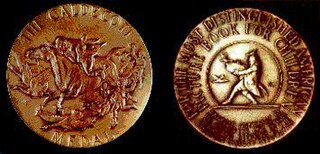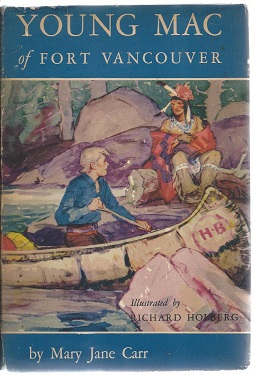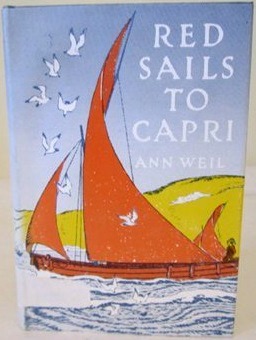Related Research Articles

The John Newbery Medal, frequently shortened to the Newbery, is a literary award given by the Association for Library Service to Children (ALSC), a division of the American Library Association (ALA), to the author of "the most distinguished contributions to American literature for children". The Newbery and the Caldecott Medal are considered the two most prestigious awards for children's literature in the United States. Books selected are widely carried by bookstores and libraries, the authors are interviewed on television, and master's theses and doctoral dissertations are written on them. Named for John Newbery, an 18th-century English publisher of juvenile books, the winner of the Newbery is selected at the ALA's Midwinter Conference by a fifteen-person committee. The Newbery was proposed by Frederic G. Melcher in 1921, making it the first children's book award in the world. The physical bronze medal was designed by Rene Paul Chambellan and is given to the winning author at the next ALA annual conference. Since its founding there have been several changes to the composition of the selection committee, while the physical medal remains the same.

The Randolph Caldecott Medal, frequently shortened to just the Caldecott, annually recognizes the preceding year's "most distinguished American picture book for children". It is awarded to the illustrator by the Association for Library Service to Children (ALSC), a division of the American Library Association (ALA). The Caldecott and Newbery Medals are considered the most prestigious American children's book awards. Besides the Caldecott Medal, the committee awards a variable number of citations to runners-up they deem worthy, called the Caldecott Honor or Caldecott Honor Books.

The Windy Hill is a children's novel by Cornelia Meigs. A brother and sister learn about their own family's history in New England through a series of tales told by the Beeman. The novel, illustrated by Berta and Elmer Hader, was first published in 1921 and was a Newbery Honor recipient in 1922.

Tod of the Fens is a children's historical novel by Elinor Whitney Field. Set in Boston, England, in the early fifteenth century, it is a light-hearted adventure about Tod, a boy who lives with a band of men outside town, and Prince Hal, the heir to the throne, who disguises himself so he can move among the people incognito. The novel, illustrated by Warwick Goble, was first published in 1928 and was a Newbery Honor recipient in 1929.

Mountains Are Free is a children's historical novel by Julia Davis Adams set in Switzerland in the 14th century. It retells the legend of William Tell and the Swiss struggle against the Habsburgs from the viewpoint of an orphan boy. The novel, illustrated by Theodore Nadajen, was first published in 1930 and was a Newbery Honor recipient in 1931.

Meggy MacIntosh is a children's historical novel by Elizabeth Janet Gray. Beginning in 1775, it follows the story of a young Scottish orphan who becomes involved with the American revolutionary cause in North Carolina despite her attachment to Flora MacDonald, a loyalist. The novel, illustrated by Marguerite de Angeli, was first published in 1930 and was a Newbery Honor recipient in 1931.
Ood-Le-Uk the Wanderer is a children's novel by Alice Alison Lide and Margaret Alison Johansen, illustrated by Raymond Lufkin and published by Little, Brown & Co., in 1930. It tells the story of an Alaskan Eskimo who crosses the Bering Strait, has many adventures and returns to establish trade between his people and the Siberian tribesmen. The novel was first published in 1930 and was a runner-up for the Newbery Medal in 1931.
Out of the Flame is a children's historical novel by Eloise Lownsbery. Set in sixteenth-century France, at the court of Francis I, it describes the education and adventures of Pierre, who is training to be a knight. The novel, illustrated by Elizabeth Tyler Wolcott, was first published in 1931 and was a Newbery Honor recipient in 1932.
Swift Rivers is a children's historical novel by Cornelia Meigs. Set initially in 1835 in Minnesota, it is a story of the early days of the logging industry, when logs were floated down the Mississippi to St. Louis. The novel, illustrated by Forrest W. Orr, was first published in 1931 and was a Newbery Honor recipient in 1933.
Whistlers' Van is a children's novel by Idwal Jones. Set in rural Wales shortly after World War I, it tells the story of a young farmboy, Gwilyn, who spends one summer traveling with the gypsies. The novel, illustrated by Zhenya Gay, was first published in 1936 and was a Newbery Honor recipient in 1937.
Winterbound is a children's novel by Margery Williams. It is a family story set in a Connecticut farmhouse during the Great Depression. Nineteen-year-old Kay and sixteen-year-old Garry are in charge of the house and their younger siblings while their parents are away during the winter. The novel, illustrated by Kate Seredy, was first published in 1936 and was a Newbery Honor recipient in 1937.
Pecos Bill: The Greatest Cowboy of All Time is a children's novel by James Cloyd Bowman about the American folk hero Pecos Bill. Raised by coyotes, the hero has various supernatural powers, including the ability to talk to animals, and becomes a spectacularly successful cowboy. The novel, illustrated by Laura Bannon, was first published in 1937 and was a Newbery Honor recipient in 1938.
Bright Island is a children's novel by Mabel Robinson. It tells the story of Thankful Curtis, who, having grown up on a small island off the coast of Maine, reluctantly agrees to attend school on the mainland for her senior year. The novel, illustrated by Lynd Ward, was first published in 1937 and was a Newbery Honor recipient in 1938.
Hello the Boat! is a children's historical novel by Phyllis Crawford. Set in 1817, it follows the journey of a store-boat down the Ohio River from Pittsburgh to Cincinnati. The novel, illustrated by Edward Laning, was first published in 1938 and was a Newbery Honor recipient in 1939.

Young Mac of Fort Vancouver is a children's historical novel by Mary Jane Carr. Set in 1832, it recounts the adventures of Donald McDermott, a young mixed-blood fur trader. The novel, illustrated by Richard Holberg, was first published in 1940 and was a Newbery Honor recipient in 1941.

Pancakes-Paris is a children's novel by Claire Huchet Bishop. Set in Paris a few months after the end of World War II, it follows Charles's quest to makes crepes for his little sister for Mardi Gras. The novel, illustrated by Georges Schreiber, was first published in 1947 and was a Newbery Honor recipient in 1948.

Li Lun, Lad of Courage is a children's novel by Carolyn Treffinger. Set on an island off the coast of China, it tells the story of a boy who tries to survive and grow rice on a barren mountain after being banished from his village. The novel, illustrated by Kurt Wiese, was first published in 1947 and was a Newbery Honor recipient in 1948.

The Quaint and Curious Quest of Johnny Longfoot is a children's comic fantasy novel by Catherine Besterman. Based on a Polish folktale, it tells the story of a shoe king's son who outwits guard dogs and a bear and is sent on a quest for gold and seven-league boots by a cat. The novel, illustrated by Warren Chappell, was first published in 1947 and was a Newbery Honor recipient in 1948.

Red Sails to Capri is a children's historical novel by Ann Weil. It tells the story of the rediscovery of Capri's Blue Grotto in 1826. The novel, illustrated by C. B. Falls, was first published in 1952 and was a Newbery Honor recipient in 1953.

Elijah of Buxton is a 2007 children's novel by Christopher Paul Curtis. The book won critical praise and was a Newbery Honor book and the winner of the Coretta Scott King Award. It also was a children's book bestseller.